NEC Notebook Computer VX User Manual
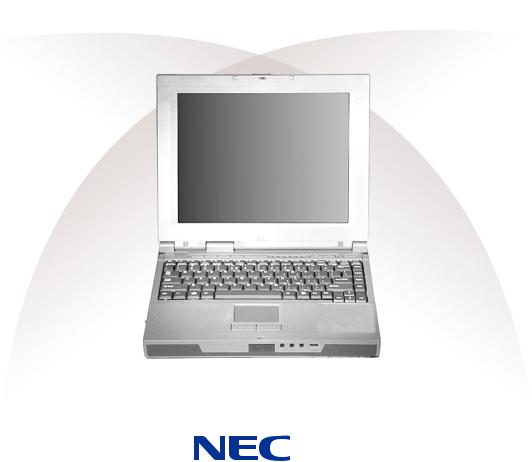
NEC Versa® VX Notebook Computer
V E R S A V X
U S E R ’ S |
G U I D E |
Proprietary Notice and Liability Disclaimer
The information disclosed in this document, including all designs and related materials, is the valuable property of NEC Computers Inc. (hereinafter “NECC”) and/or its licensors. NECC and/or its licensors, as appropriate, reserve all patent, copyright and other proprietary rights to this document, including all design, manufacturing, reproduction, use, and sales rights thereto, except to the extent said rights are expressly granted to others.
The NECC product(s) discussed in this document are warranted in accordance with the terms of the Warranty Statement accompanying each product. However, actual performance of each such product is dependent upon factors such as system configuration, customer data, and operator control. Since implementation by customers of each product may vary, the suitability of specific product configurations and applications must be determined by the customer and is not warranted by NECC.
To allow for design and specification improvements, the information in this document is subject to change at any time, without notice. Reproduction of this document or portions thereof without prior written approval of NECC is prohibited.
As an ENERGY star partner, NEC Computers Inc. (NECC) has determined that this product meets the ENERGY star guidelines for energy efficiency.
NEC and Versa are registered trademarks of NEC Corporation and/or one or more of its subsidiaries.
ENERGY STAR is a U.S. registered trademark.
All other product, brand, or trade names used in this publication are the trademarks or registered trademarks of their respective trademark owners.
First Printing — January 2000
Copyright 2000
NEC Computers Inc.
15 Business Park Way
Sacramento, CA 95828
All Rights Reserved

Contents
Using This Guide
Text Conventions .................................................................................................................. |
x |
Related Documents................................................................................................................ |
x |
1 Introducing the NEC Versa |
|
Before You Begin............................................................................................................... |
1-2 |
About Your NEC Versa VX Notebook .............................................................................. |
1-3 |
Around the Front of the System.......................................................................................... |
1-4 |
LCD Panel ................................................................................................................... |
1-4 |
Control Panel............................................................................................................... |
1-5 |
Power Button........................................................................................................ |
1-6 |
Status Icons .......................................................................................................... |
1-7 |
Keyboard Panel and Base Unit.................................................................................... |
1-8 |
Around the Back of the System ........................................................................................ |
1-12 |
Around the Left Side of the System ................................................................................. |
1-13 |
Around the Right Side of the System ............................................................................... |
1-14 |
Around the Bottom of the System .................................................................................... |
1-15 |
About the Port Replicator ................................................................................................. |
1-16 |
2 Getting Started |
|
NEC VersaGlide................................................................................................................. |
2-2 |
Making VersaGlide Adjustments ................................................................................ |
2-3 |
VersaGlide Tips .......................................................................................................... |
2-3 |
Power Sources .................................................................................................................... |
2-3 |
Using the AC Adapter ................................................................................................. |
2-4 |
Powering the System On and Off................................................................................ |
2-5 |
Using the Battery......................................................................................................... |
2-5 |
Replacing the Battery .................................................................................................. |
2-6 |
Low Battery Power...................................................................................................... |
2-8 |
Returning the Battery to its Normal State ................................................................... |
2-8 |
Handling the Battery ................................................................................................... |
2-9 |
Extending Battery Life ................................................................................................ |
2-9 |
Charging the Battery ................................................................................................. |
2-10 |
Battery Precautions ................................................................................................... |
2-10 |
Precautions for Recharging the Battery..................................................................... |
2-11 |
Disposing of the Battery............................................................................................ |
2-11 |
Internal Batteries ....................................................................................................... |
2-11 |
CMOS Battery.................................................................................................... |
2-11 |
System Care...................................................................................................................... |
2-12 |
Precautions ................................................................................................................ |
2-12 |
Storage Requirements................................................................................................ |
2-14 |
Routine Cleaning....................................................................................................... |
2-15 |
Contents iii

3 Using the BIOS Setup Utility |
|
Introducing BIOS Setup .................................................................................................... |
3-2 |
Entering BIOS Setup ......................................................................................................... |
3-2 |
BIOS Setup Main Menu ............................................................................................. |
3-3 |
Looking at Screens ..................................................................................................... |
3-4 |
Using Keys ................................................................................................................. |
3-5 |
Checking/Setting System Parameters ................................................................................ |
3-5 |
Resetting System Parameters...................................................................................... |
3-6 |
Standard CMOS Setup................................................................................................ |
3-6 |
Advanced CMOS Setup.............................................................................................. |
3-7 |
System Security Setup ................................................................................................ |
3-8 |
Password Protection ................................................................................................... |
3-9 |
Establishing Passwords............................................................................................... |
3-9 |
Hard Disk Drive Passwords........................................................................................ |
3-9 |
Establishing Hard Disk Drive Passwords .......................................................... |
3-10 |
Changing Hard Disk Drive Passwords .............................................................. |
3-10 |
Using Hard Disk Drive Password Protection .................................................... |
3-10 |
Moving the Hard Disk Drive ............................................................................. |
3-11 |
Power Management Setup ........................................................................................ |
3-11 |
Boot Device Setup .................................................................................................... |
3-14 |
Peripheral Setup........................................................................................................ |
3-15 |
Other BIOS Setup Options ....................................................................................... |
3-16 |
Managing System Power ................................................................................................. |
3-16 |
Windows 98 Power Management Properties............................................................ |
3-16 |
Windows 98 Power Schemes.................................................................................... |
3-17 |
Windows 98 Alarms ................................................................................................. |
3-18 |
Windows 98 Power Meter ........................................................................................ |
3-18 |
Windows 98 Advanced............................................................................................. |
3-19 |
Windows 98 Hibernate ............................................................................................. |
3-19 |
Windows 98 Power Management States .................................................................. |
3-20 |
Recognizing the Windows 98 Power Management States........................................ |
3-20 |
Windows 95 Power Management States .................................................................. |
3-21 |
Recognizing the Windows 95 Power Management States........................................ |
3-21 |
Updating the BIOS .......................................................................................................... |
3-22 |
Obtaining the BIOS Update...................................................................................... |
3-22 |
Preparing the BIOS Update Diskette ........................................................................ |
3-23 |
Performing the BIOS Update.................................................................................... |
3-23 |
Identifying the Switch Settings........................................................................................ |
3-24 |
4 Using the Operating System and Utilities |
|
Windows Introduction ....................................................................................................... |
4-2 |
Windows 98 Second Edition ...................................................................................... |
4-2 |
Desktop Icons ...................................................................................................... |
4-2 |
Taskbar Icons ...................................................................................................... |
4-3 |
Windows 95................................................................................................................ |
4-4 |
Windows NT .............................................................................................................. |
4-5 |
iv Contents

NEC Customize Utility....................................................................................................... |
4-5 |
Using the NEC Customize Utility ........................................................................ |
4-6 |
HDPREPEZ Utility ............................................................................................................ |
4-6 |
Using HDPREPEZ in Windows 98 or 95.................................................................... |
4-6 |
Application and Driver CD ................................................................................................ |
4-7 |
Launching the Application and Driver CD with Windows 98/95 ............................... |
4-7 |
Launching the Application and Driver CD with Windows NT ................................... |
4-7 |
Application and Driver CD Dialog Box ...................................................................... |
4-8 |
Installing the A&D Software....................................................................................... |
4-8 |
Personal Code Setting Utility ............................................................................................. |
4-8 |
Installing the Personal Code Setting Utility ................................................................ |
4-9 |
Setting a Personal Code............................................................................................... |
4-9 |
DVD Player ...................................................................................................................... |
4-10 |
NEC Info Center............................................................................................................... |
4-10 |
Installing the NEC Info Center.................................................................................. |
4-10 |
Uninstalling the NEC Info Center ............................................................................. |
4-11 |
Partition Magic ................................................................................................................. |
4-11 |
Product Recovery CD....................................................................................................... |
4-12 |
Guidelines for Using the Product Recovery CD ....................................................... |
4-12 |
Product Recovery CD Options .................................................................................. |
4-13 |
Full Disk Drive Restore............................................................................................. |
4-13 |
Partition Only Restore ............................................................................................... |
4-15 |
System Diagnostics ................................................................................................... |
4-16 |
5 Using the System Drives and Bays |
|
24X CD-ROM Drive .......................................................................................................... |
5-2 |
CD Loading ................................................................................................................. |
5-3 |
CD Care....................................................................................................................... |
5-3 |
Changing the Auto Play Setting .................................................................................. |
5-3 |
DVD-ROM Drive............................................................................................................... |
5-4 |
Hard Disk Drive ................................................................................................................. |
5-5 |
Memory Modules ............................................................................................................... |
5-6 |
6 Communicating with Your NEC Versa |
|
Mini-PCI Modem ............................................................................................................... |
6-2 |
Connecting the Modem ............................................................................................... |
6-2 |
Mini-PCI LAN ................................................................................................................... |
6-3 |
Mini-PCI Modem/LAN ...................................................................................................... |
6-3 |
Installing the Online Modem/LAN Guides ................................................................. |
6-3 |
PC Cards............................................................................................................................. |
6-3 |
Type II Cards............................................................................................................... |
6-4 |
Type II Extended Cards............................................................................................... |
6-4 |
Type III Cards ............................................................................................................. |
6-4 |
Communication Cards................................................................................................. |
6-4 |
Storage Cards .............................................................................................................. |
6-5 |
Contents v

|
Interface Cards............................................................................................................ |
6-5 |
|
Other Cards................................................................................................................. |
6-5 |
|
PC Card Slots ............................................................................................................. |
6-5 |
|
Inserting a PC Card..................................................................................................... |
6-6 |
|
Removing a Card ........................................................................................................ |
6-7 |
|
Internet Connections .......................................................................................................... |
6-7 |
|
Internet Connection Wizard in Windows 98 .............................................................. |
6-7 |
|
Internet Connection Wizard in Windows 95 .............................................................. |
6-8 |
|
Accessing the Internet ................................................................................................ |
6-8 |
|
Sending and Receiving Email..................................................................................... |
6-8 |
|
Modifying the Internet and Email Shortcut Keys ....................................................... |
6-9 |
|
IR Port ............................................................................................................................... |
6-9 |
|
Enabling the IR Port ................................................................................................. |
6-10 |
|
Using the IR Port ...................................................................................................... |
6-10 |
7 |
Traveling Tips |
|
|
Preparing for Travel........................................................................................................... |
7-2 |
|
Packing for Travel ............................................................................................................. |
7-2 |
|
Using Power Connections.................................................................................................. |
7-3 |
|
Getting Through Customs.................................................................................................. |
7-3 |
|
Using Your Modem ........................................................................................................... |
7-4 |
8 |
Using External Devices |
|
|
Monitor .............................................................................................................................. |
8-2 |
|
Parallel Devices ................................................................................................................. |
8-3 |
|
Serial Devices .................................................................................................................... |
8-4 |
|
Keyboard/Mouse................................................................................................................ |
8-5 |
|
Television Connection ....................................................................................................... |
8-6 |
|
USB Device ....................................................................................................................... |
8-7 |
|
Audio Options.................................................................................................................... |
8-8 |
|
Port Replicator ................................................................................................................... |
8-8 |
9 |
Using Multimedia |
|
|
Audio ................................................................................................................................. |
9-2 |
|
Recording ................................................................................................................... |
9-2 |
|
Line-In ........................................................................................................................ |
9-3 |
|
CD-ROM Input........................................................................................................... |
9-3 |
|
Microphone................................................................................................................. |
9-3 |
|
Playing Back............................................................................................................... |
9-4 |
|
Using Headphones...................................................................................................... |
9-4 |
|
Using the Built-In Speakers........................................................................................ |
9-4 |
|
Using External Stereo Speakers.................................................................................. |
9-4 |
|
Video ................................................................................................................................. |
9-5 |
|
Using Digital Video Files ........................................................................................... |
9-5 |
|
Using Animation Files................................................................................................ |
9-5 |
vi Contents

|
Multimedia Applications .................................................................................................... |
9-6 |
10 |
Solving System Problems |
|
|
Problem Checklist ............................................................................................................ |
10-2 |
|
Startup Problems .............................................................................................................. |
10-3 |
|
POST Error Messages ............................................................................................... |
10-4 |
|
If You Need Assistance .................................................................................................... |
10-5 |
11 Getting Service and Support |
|
|
|
Service and Support Contact Information ........................................................................ |
11-2 |
|
NECC Web Site................................................................................................................ |
11-3 |
|
NECC FTP Site ................................................................................................................ |
11-3 |
|
NECC Support Services ................................................................................................... |
11-3 |
|
Email/Fax to Support Services ......................................................................................... |
11-4 |
A Setting Up a Healthy Work Environment |
|
|
|
Making Your Computer Work for You ............................................................................. |
A-2 |
|
Arrange Your Equipment .................................................................................................. |
A-3 |
|
Adjust Your Chair ............................................................................................................. |
A-3 |
|
Adjust Your Input Devices ................................................................................................ |
A-4 |
|
Adjust Your Screen or Monitor ......................................................................................... |
A-4 |
|
Vary Your Workday .......................................................................................................... |
A-5 |
|
Pre-existing Conditions and Psychosocial Factors ............................................................ |
A-5 |
B |
Specifications |
|
|
System Components .......................................................................................................... |
B-2 |
|
Interrupt Controllers .......................................................................................................... |
B-7 |
|
Memory Map ..................................................................................................................... |
B-8 |
C |
Frequently Asked Questions |
|
|
External Mouse.................................................................................................................. |
C-2 |
|
Display .............................................................................................................................. |
C-2 |
|
PC Cards............................................................................................................................ |
C-3 |
|
Diskette Drive.................................................................................................................... |
C-4 |
|
Booting .............................................................................................................................. |
C-6 |
|
Power Management ........................................................................................................... |
C-6 |
|
Miscellaneous .................................................................................................................... |
C-9 |
Glossary
Index
Contents vii

Using This Guide
The NEC Versa® VX User’s Guide gives you the information you need to maximize the use of your NEC Versa notebook computer. Read this guide to familiarize yourself with the NEC Versa and its features. For specific information see
!Chapter 1, “Introducing the NEC Versa,” to acquaint yourself with system hardware.
!Chapter 2, “Getting Started,” for instructions on how to connect, power on, and care for your system.
!Chapter 3, “Using the BIOS Setup Utility,” for details about modifying system parameters and power management.
!Chapter 4, “Using the Operating System and Utilities,” for an understanding of your Windows operating system. You’ll also learn how to use the system utilities and CDs for loading applications, drivers, and the NEC Info Center.
!Chapter 5, “Using the System Drives and Bays,” to master procedures for upgrading the internal hard disk drive and installing a memory module.
!Chapter 6, “Communicating with Your NEC Versa,” for essential information about using PC cards, the mini-PCI modem, mini-PCI LAN, or mini-PCI modem/LAN, and other communication features of the system.
!Chapter 7, “Traveling Tips,” for a variety of checklists to help you to prepare the notebook computer for travel, getting through customs and using your modem when you are on the road.
!Chapter 8, “Using External Devices,” for procedures for connecting external devices like an external monitor, headphones, a printer, or speakers.
!Chapter 9, “Using Multimedia,” for steps on integrating video and sound clips into impressive presentations.
!Chapter 10, “Solving System Problems,” for simple solutions to common problems that may arise while operating your notebook.
!Chapter 11, “Getting Service and Support,” for information about getting help when you need it from NEC Computers Inc. (NECC).
!Appendix A, “Setting Up a Healthy Work Environment,” for guidelines that help promote a healthy work setting.
!Appendix B, “Specifications,” to review NEC Versa system specifications.
Using This Guide ix
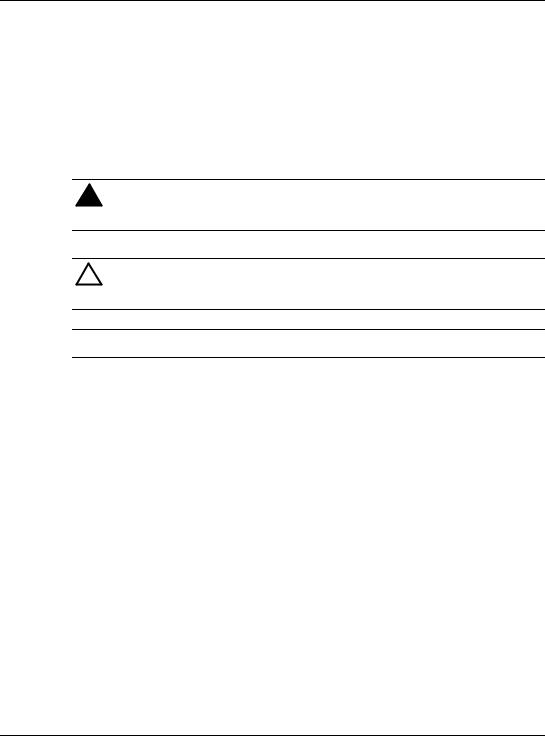
!Appendix C, “Frequently Asked Questions,” (FAQs) for a look at questions that users commonly ask and the answers to those questions.
Text Conventions
To make this guide as easy as possible to use, text is set up as follows.
! Warnings, cautions, and notes have the following meanings:




 Warnings alert you to situations that could result in serious personal injury or loss of life.
Warnings alert you to situations that could result in serious personal injury or loss of life.




 Cautions indicate situations that can damage the hardware or software.
Cautions indicate situations that can damage the hardware or software.
Note Notes give important information, etc.
!Names of keys are printed as they appear on the keyboard, for example, Ctrl, Alt, or
Enter.
!Text that you must type or keys that you must press are presented in bold type. For example, type dir and press Enter.
Related Documents
See the following documents for additional information on your NEC Versa notebook computer:
!The NEC Versa VX Quick Setup sheet helps get your system up and running.
!The NEC Versa VX Quick Reference card provides an easy-to-carry reference to LED meanings, controls, function key combinations, and NECC help numbers. (The quick reference card does not ship with some systems purchased outside of the United States and Canada.)
The NEC Info Center is a fully navigational, pdf document containing multimedia elements, a full search capability, and all of the information about your NEC Versa that you find in this printed user’s guide, and more.
x Using This Guide
1
Introducing the NEC Versa
!Before You Begin
!About Your NEC Versa VX Notebook
!Around the Front of the System
!Around the Back of the System
!Around the Left Side of the System
!Around the Right Side of the System
!Around the Bottom of the System
!About the Port Replicator

Before You Begin




 Prolonged or improper use of a computer workstation may pose a risk of serious injury. To reduce your risk of injury, set up and use your computer in the manner described in Appendix A, Setting Up a Healthy Work Environment.
Prolonged or improper use of a computer workstation may pose a risk of serious injury. To reduce your risk of injury, set up and use your computer in the manner described in Appendix A, Setting Up a Healthy Work Environment.
After completing the steps in the quick setup sheet that comes with your computer, your NEC Versa VX system is ready to go! To get started, do the following:
!Read Appendix A, “Setting Up a Healthy Work Environment,” for guidelines that help you use your computer productively and safely. Information includes how to set up and use your computer to reduce your risk of developing nerve, muscle, or tendon disorders.
!Read through this guide to familiarize yourself with the NEC Versa.
1-2 Introducing the NEC Versa
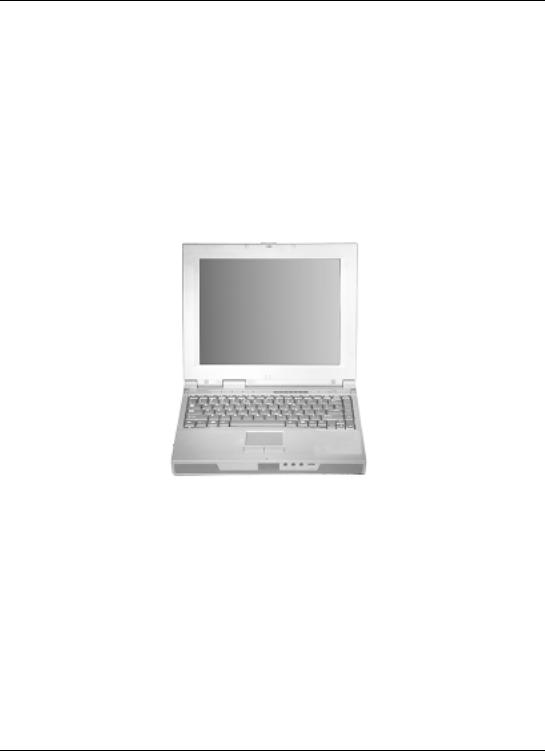
About Your NEC Versa VX Notebook
The NEC Versa VX notebook computer offers you a portable system filled with exciting resources for home, business or travel. Standard features include a powerful Intel® Celeron™, Pentium ® II or Pentium III microprocessor that works together with the latest Peripheral Component Interconnect (PCI) architecture.
In addition, your system provides a high-performance hard disk drive, diskette drive, and PC card support. Most models are equipped with a 24X CD-ROM drive, or a DVD-ROM drive. and a V.90-compliant 56 kilobits per second (Kbps) modem. As a multimedia system, your NEC Versa VX provides the tools needed to create and present impressive images using video clips and sound.
NEC Versa VX notebook computer
To get comfortable with your notebook, read the following sections and take a tour around your system!
Introducing the NEC Versa 1-3
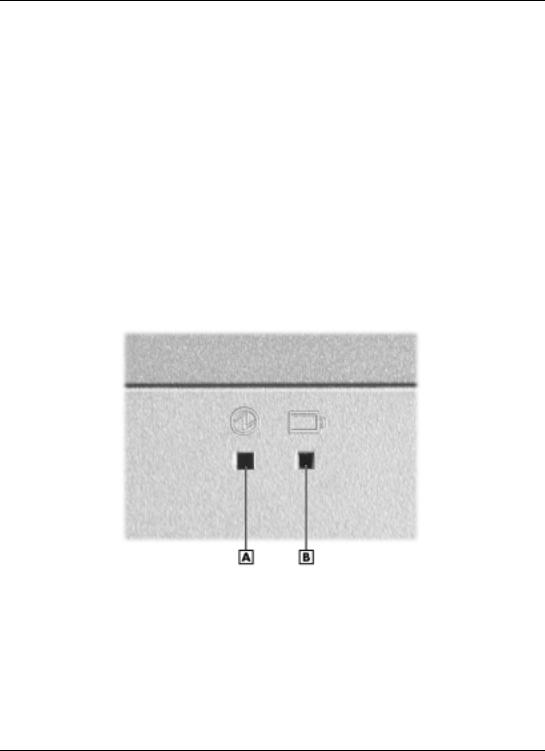
Around the Front of the System
The NEC Versa is compact with features on every side. First, look at the front of the system. The following sections describe front features, beginning with the liquid crystal display (LCD) panel.
LCD Panel
The NEC Versa VX comes with a color LCD panel that you can adjust for a comfortable viewing position. The LCD panel can be a 12.1-inch Super Video Graphics Array (SVGA) color display, or a 13.3/14.1-inch Extended Graphics Array (XGA).
!Power and Battery Charging Status LEDs — (identified by icons) are located just under the front of the LCD panel. The status LEDs are duplicated on the back of the LCD panel to allow viewing when the panel is closed.
Power and Battery Charging LEDs
A – Power LED |
B – Battery Charging LED |
1-4 Introducing the NEC Versa
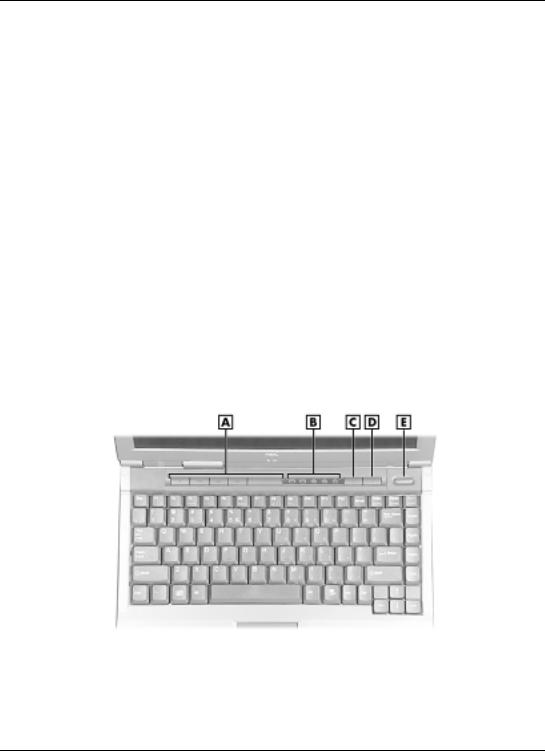
—Power LED — lets you know that power to the system is turned on. This LED is positioned so that you see the power state whether the LCD panel is opened or closed.
–Lights green when the system is powered on using the AC adapter, battery, or auto adapter.
–Lights green when on and has normal battery power. Lights yellow when on and low (8% to 4%) battery power. Lights amber when in Windows 95 Suspend mode or Windows 98 Standby mode and very low (3% or less) battery power.
—Battery Charging LED — lights to indicate battery charging status.
–Lights amber to indicate the battery is charging.
–Blinks amber to indicate an error.
–Lights off to indicate the battery is fully charged.
Control Panel
The NEC Versa VX Control Panel provides the features shown in the following figure. The Control Panel features are described after the figure.
Control Panel
A – CD Control Buttons or Password Buttons |
D – Internet Button |
B – Status LEDs |
E – Power Button |
C – Email Button |
|
Introducing the NEC Versa 1-5

!CD Control Buttons — controls the CD-ROM drive (stop, reverse, play/pause, and fast forward). Available on some systems.
!Personal Code Buttons — sets a personal code for security. Available on some systems.
!Status LEDs — keeps you informed of your NEC Versa VX’s current operating status. Descriptions of the status icons appear in the following section.
!Email Button — accesses your email software.
!Internet Button — accesses the Internet.
!Power Button — powers on and off the system.
Note If you are unable to power off the system, use the power override. Press the Power button and hold it in place until the system powers off.
Power Button
The Power button is a “smart” switch, meaning that it recognizes when the system is in Suspend (Windows 95) or Standby (Windows 98) mode, if the BIOS parameter “System Switch” is set to “Sleep.” If in Suspend or Standby mode, you cannot power off until you press the Power button to resume operation.
Put the unit in Suspend or Standby mode when you need to be away from your system for a short period of time and want to return to where you left off. Suspend mode in Windows 95 and Standby mode in Windows 98 shuts down all devices in the system while retaining data and system status.
!In Windows 95, press the Power button for less than 4 seconds to put your system into Suspend mode.
!In Windows 98, go to Start, Shutdown, Standby to put your system into Standby mode.
!Use the Power button in the following ways:
—Press the Power button to power on.
—Press the Power button to resume from Suspend (Windows 95) or Standby (Windows 98) mode and proceed with normal operation.
—Hold the Power button in place for 4 or more seconds to initiate power override (powers off the system). Only use this option if you cannot power off your system using Start, Shutdown.
1-6 Introducing the NEC Versa
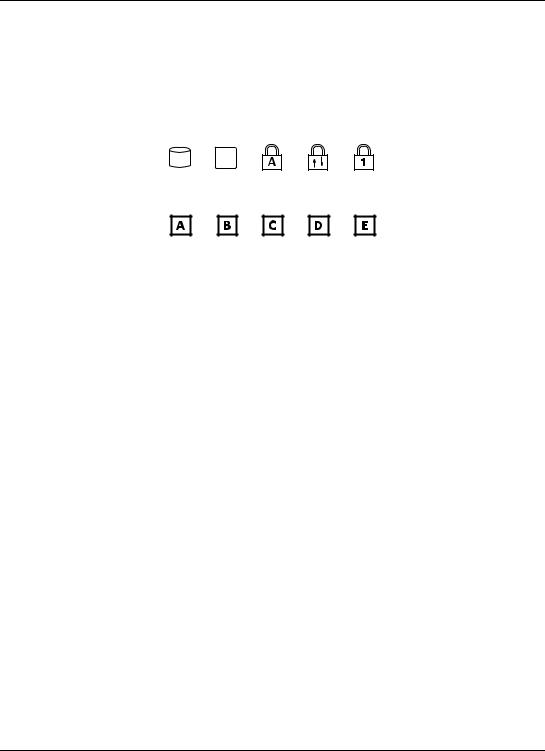
Status Icons
The NEC Versa VX system uses status lights marked with icons to communicate system status. See the following figure and list for each icon’s meaning.
Status LED icons
|
|
|
|
|
|
|
|
|
|
|
|
|
|
|
|
|
|
|
|
|
|
|
|
|
|
|
|
|
|
|
|
|
|
|
|
|
|
|
|
|
|
|
|
|
|
|
|
|
|
|
|
|
|
|
|
|
|
|
|
|
|
|
|
|
|
|
|
|
|
|
|
|
|
|
|
|
|
|
|
|
|
|
|
|
|
|
|
|
|
|
|
|
|
|
|
A – Hard Drive Access |
|
|
|
|
D – Scroll Lock |
||||||||||
B – Diskette Drive Access |
|
|
|
|
E – Num Lock |
||||||||||
C – Caps Lock |
|
|
|
|
|
|
|
|
|
|
|||||
!Hard Drive Access — lights when the NEC Versa VX accesses the hard disk drive, CD-ROM drive, or DVD-ROM drive.
!Diskette Drive Access — lights when the NEC Versa VX writes data to or retrieves data from the diskette drive.
!Caps Lock — lights when caps lock is in effect.
!Scroll Lock — lights when scroll lock is in effect.
!Num Lock — lights when Num Lock mode is active.
Introducing the NEC Versa 1-7

Keyboard Panel and Base Unit
The NEC Versa VX keyboard panel and base unit contain the following features. The keyboard panel and base unit features are described after the figure.
Keyboard panel
A – Keyboard |
B – NEC VersaGlide |
Base unit
A – Speakers |
D – Audio Ports |
B – IR Port |
E – Volume Control |
C – Microphone |
|
1-8 Introducing the NEC Versa
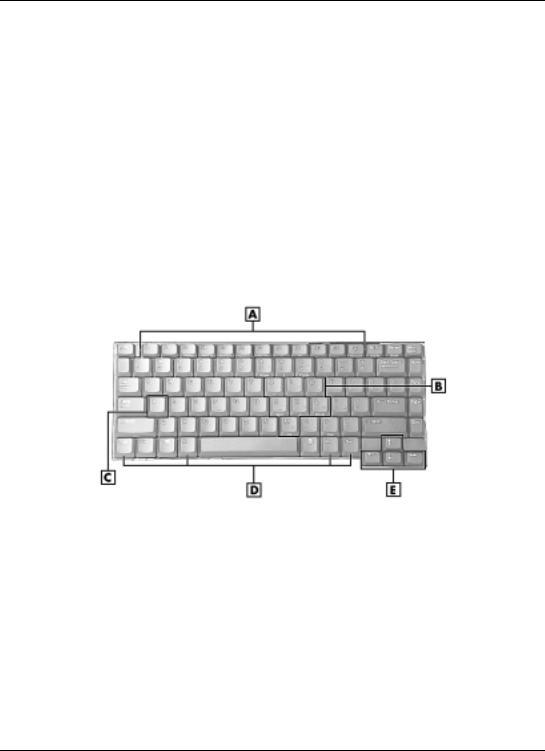
!Keyboard — standard QWERTY-key layout. (Models shipped outside of the U.S. are equipped with country-specific keyboard layouts.) The keyboard is equipped with many features. These include:
—Function keys
—Windows keys
—Cursor control keys
—Typewriter keys
—Numeric keypad
—Control keys.
Key features and operations are described after the figure.
Keyboard
A – Function Keys |
D – Control Keys |
B – Numeric Keypad |
E – Cursor Control Keys |
C – Typewriter Keys |
|
!Function Keys — Twelve function keys, F1 through F12, are available on the NEC Versa VX keyboard. These keys work together with the Fn key to activate special functions. Eight keys (printed in blue) are preprogrammed with dual functions.
Function keys are application-driven. See the specific application’s user guide for information about how each function key works within the application you are using.
The following function key combinations are pre-programmed for the NEC Versa VX.
Introducing the NEC Versa 1-9

Fn-Left Ctrl — Simulates pressing the right control key to support IBM 327X connections.
Fn-F3 — Toggles the video mode between LCD only, CRT only, Simultaneous mode, and TV out.
Fn-F4 — Sets standby power management mode on, in Windows 95.
—In Windows 95, press any key to resume from Standby mode.
—No function when Windows 98 configured for Advanced Configuration and Power Interface (ACPI). In Windows 98, Standby is equivalent to Windows 95 Suspend mode. To resume from Windows 98 Standby mode, press the Power button.
Fn-F6 — Toggles the system beep off and on.
Fn-F7 — Toggles between various power management levels in Windows 95. Beeps indicate the level chosen as follows:
1 beep |
Off |
2 beeps |
Custom |
3 beeps |
Highest Performance |
4 beeps |
Longest Life |
No function when Windows 98 configured for Advanced Configuration and Power Interface (ACPI).
Fn-F8 — Increases the LCD’s brightness (eight settings). Applies to XGA LCD panels only.
Fn-F9 — Reduces the LCD’s brightness (eight settings). Applies to XGA LCD panels only.
Fn-F10 — Provides zoom in/out control.
Fn-F12 — Toggles the scroll lock feature.
Fn-Power — Initiates a save-to-file on demand, only in Windows 95, when the BIOS Suspend option is set to “STF.” Saves your working environment to a reserved area on the hard drive.
Fn-ESC — Initiates a Save-to-Ram, only in Windows 95, when the BIOS System Switch is set to “Sleep.” Saves your working environment to memory.
1-10 Introducing the NEC Versa

Windows keys — Use the following two keys to facilitate your work.
—Shortcut/Application key – provides quick access to shortcut menus. (This key acts like a right mouse button.)
—Floating Window key – displays the Start menu.
!Numeric Keypad — Pressing Num Lock on the keyboard activates the numeric keypad numbers and functions printed in blue on top of the keys.
The keypad lets you type numbers and mathematical operands (+, –) as you would on a calculator. The keypad is ideal for entering long lists of numbers.
When you press Num Lock again, the keys revert to their normal functions as typewriter keys.
!Typewriter keys — Typewriter keys (also called alphanumeric keys) are used to enter text and characters. Keys with blue print on them behave differently when combined with control keys or the Fn key.
!Control keys — Ctrl, Alt, Fn, and Shift are controls used in conjunction with other keys to change their functions. To use control keys, press and hold the control key while pressing another key. For example, “Press Ctrl c” means to hold down the Ctrl key and type the letter c. Key combinations work specific to the application you are running.
!Cursor Control keys — Cursor control keys let you position the cursor on the screen where you want. On the screen, the cursor is a blinking underline, block, or vertical bar depending on the application. The cursor indicates where the next text typed is inserted.
!NEC VersaGlide — works like a standard computer mouse. Simply move your fingertip over the VersaGlide to control the position of the cursor. Use the selection buttons below the VersaGlide to select menu items. See “Using the NEC VersaGlide” in Chapter 2 for information about customizing VersaGlide settings.
!Speakers — provides stereo sound for your multimedia presentations or listening pleasure.
!IR Port — allows you to transfer files between you NEC Versa and an IR-equipped desktop or notebook computer.
!Microphone — allows you to record monophonic sound directly into your notebook computer. See Chapter 9, “Using Multimedia,” for details about recording.
!Audio Ports
—Microphone — Allows you to connect an external microphone for monophonic recording or amplification through the unit. Plugging in an external microphone disables the built-in microphone.
Introducing the NEC Versa 1-11

—Line In — Lets you use another audio system, like a home stereo, as an input source. Use a cable to connect to the Line-Out port on the other audio system to record or play.
—Headphones — Lets you plug in stereo headphones or powered speakers.
!Volume Control — Allows you to control the speaker volume through the thumb wheel.
Around the Back of the System
You’ll find system ports for connecting your NEC Versa VX to optional devices (like a printer or external monitor) on the back of your NEC Versa VX. The ports are described after the figure.
Back system features
A – Port Replicator Notches |
F – VGA Port |
B – PS/2 Port |
G – Serial Port |
C – AC Power Port |
H – USB Ports |
D – Parallel Port |
I – Modem/LAN Port |
E – Expansion Port |
|
!Port Replicator Notches — Use these notches to secure the Port Replicator to the back of the system. (There are two Port Replicator notches located at the both ends of the rear side of the system.)
!PS/2 Port — Use the standard PS/2 port to connect an external PS/2-style mouse, PS/2-style keyboard, or PS/2 style Numeric Keypad to the system. With an optional Y-adapter cable, you can connect up to two of these devices at the same time.
!AC Power Port — Lets you attach the NEC Versa VX to the AC power source using the AC adapter that comes with your system. Keep the system connected to AC power whenever possible to keep the battery pack and internal CMOS battery charged.
1-12 Introducing the NEC Versa

!Parallel Port — Use this port to connect a parallel printer or other parallel device. The parallel port default supports the Enhanced Capabilities Port (ECP) standard. The port also supports bidirectional and output only protocols.
!Expansion Port — Use this port to connect the Port Replicator.
!VGA Port — Use this 15-pin port to attach an external monitor to your NEC Versa VX.
!Serial Port — Use this port to connect a serial printer or other serial device.
!USB Ports — Each Universal Serial Bus (USB) port allows you to connect up to 127 USB-equipped peripheral devices (for example, printers, monitors, scanners) to your NEC Versa VX.
!Modem/LAN Port — NEC includes a 56K fax/data modem or mini-PCI LAN. It keeps you connected to the outside world!
Around the Left Side of the System
The left side of your NEC Versa VX provides the features shown in the following figure. The left side features are described after the figure.
Left side features
A – Kensington Lock Latch |
C – Diskette Drive |
B – CD-ROM Drive |
D – Hard Disk Drive |
!Kensington Lock Latch — This latch allows you to attach a Kensington security lock or other compatible lock to secure the notebook from theft.
!CD-ROM Drive — Allows you to load and start programs from a compact disc (CD) and play audio CDs.
!Diskette Drive — A 3.5-inch, 1.44-MB diskette drive comes installed in the NEC Versa.
Introducing the NEC Versa 1-13

!Hard Disk Drive — An internal hard disk drive comes installed in the NEC Versa. The disk drive is upgradeable.
Around the Right Side of the System
The right side of the NEC Versa VX offers the features shown in the following figure. The right side features are described after the figure.
Right side features
A – Battery Bay |
C – PC Card Slots |
B – Fan |
D – TV Out |
!Battery Bay — Depending upon the model, the battery bay contains a rechargeable Nickel-Metal-Hydride (NiMH) or Lithium-Ion (Li-Ion) battery pack.
!Fan — Allows your system to cool properly and maintain a safe operating environment.
Do not block the fan while the NEC Versa VX is in use.
!PC Card Slots — Two PC card slots allow you to insert two Type II PC cards or one Type III PC card in the bottom slot. Card BUS cards are supported and Zoom Video is supported in the top slot.
!TV Out — Allows you to connect to a television.
1-14 Introducing the NEC Versa
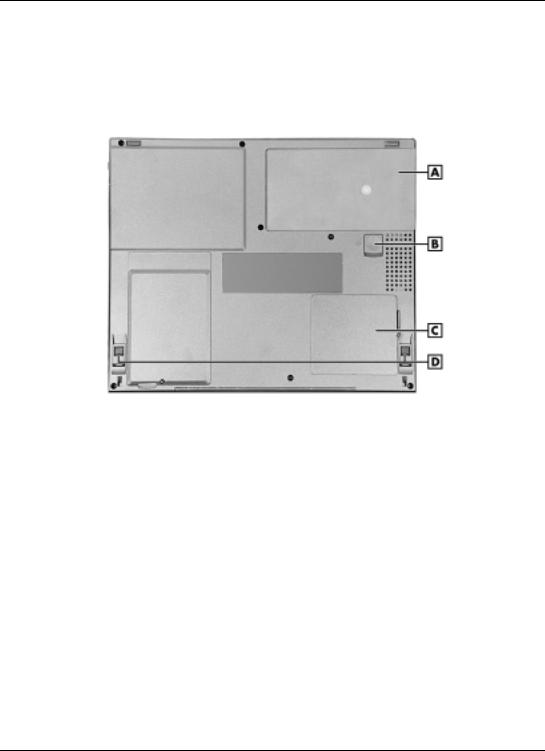
Around the Bottom of the System
The bottom of the NEC Versa VX offers the following features. The features are described after the figure.
Bottom of the system
A – Battery Bay |
C – Memory Module Bay Cover |
B – Battery Release Latch |
D – Tilt Foot |
!Battery Bay — Equipped with a rechargeable Nickel-Metal-Hydride (NiMH) or (depending on the model) Lithium-Ion (Li-Ion) battery.
!Battery Release Latch — Slide the latch to the other end and hold it. While holding the latch, slide the battery bay outwards to remove the battery.
!Memory Module Bay Cover — Remove the screw to find two SO-DIMM slots. One is inserted with SDRAM memory board configured by the factory. The other is empty for upgrade use.
!Tilt Foot — Adjust to provide flexible keyboard angle.
Introducing the NEC Versa 1-15
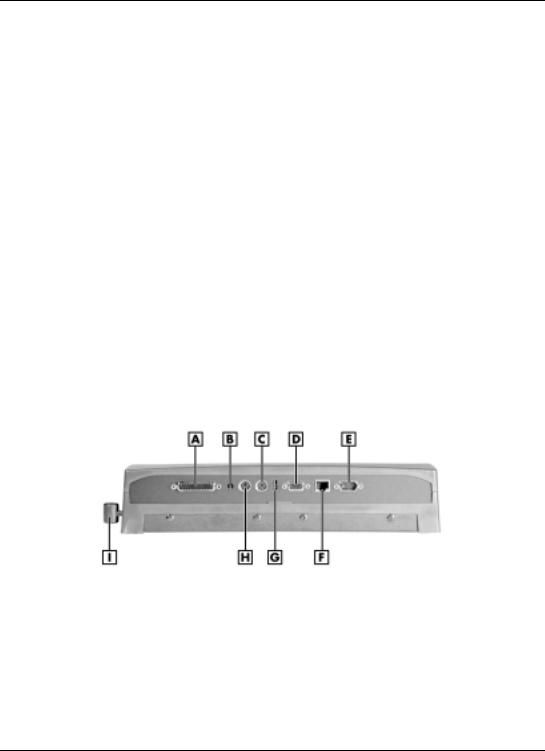
About the Port Replicator
The NEC Port Replicator is an accessory that duplicates some of the ports found on the back of your NEC Versa VX system. It also has a LAN port for a network connection and a Kensington lock. The lock secures the NEC Versa VX to the Port Replicator and secures the Port Replicator to the desk. Keep the NEC Port Replicator in your office connected to peripherals while you take your NEC Versa VX on the road.
The ports on the Port Replicator are as follows.
!Parallel Port — Connects to a printer. You can change the LPT Mode in the Setup program.
!AC Power Port — Connects to an AC adapter.
!PS/2 Mouse Port — Connects to a PS/2 mouse.
!PS/2 Keyboard Port — Connects to a 6-pin standard PS/2-style keyboard.
!USB Port — Connects up to 127 peripheral devices to your notebook computer.
!VGA Port — Connects to an external VGA/SVGA monitor.
!LAN Port — Connects via an RJ45 connector to the system’s built-in LAN or modem/LAN card.
!Serial Port — Connects to a serial device, such as an external modem.
Port Replicator
A – Parallel Device Port |
D – VGA Port |
G – USB Port |
B – AC Power Port |
E – Serial Device Port |
H – Mouse Port |
C – External Keyboard Port |
F – Ethernet LAN Port |
I – Docking Lever |
1-16 Introducing the NEC Versa
2
Getting Started
!NEC VersaGlide
!Power Sources
!System Care
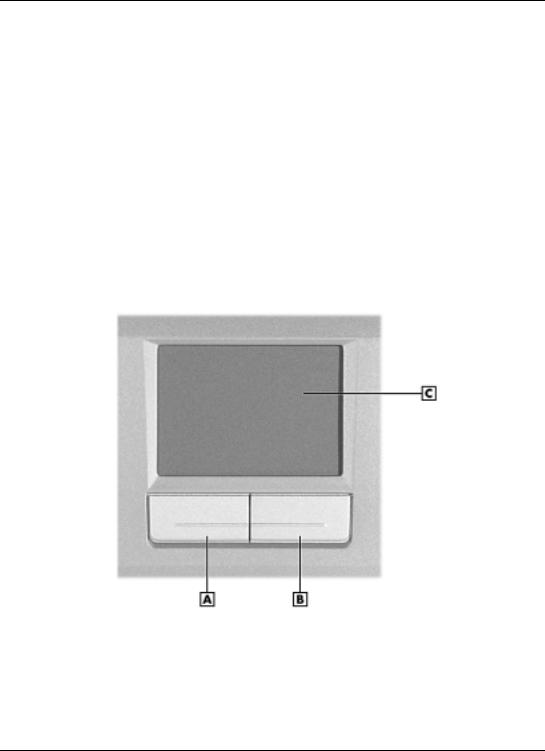
NEC VersaGlide
The NEC VersaGlide is an easy way to control the cursor with your finger. Lightly glide your finger across the NEC VersaGlide and the cursor follows. To use the VersaGlide, you can
!Single tap to the touchpad, equivalent to a single click of the primary mouse button.
!Double tap to the touchpad, equivalent to a double click of the primary mouse button.
!Click and hold, then drag your finger across the VersaGlide touchpad, equivalent to a click and drag of the primary mouse button.
!Slide your finger along the right side of the touchpad to scroll your document or screen.
VersaGlide features
A – Left Button |
C – NEC VersaGlide |
B – Right Button |
|
Try both ways and decide which you prefer. If you find the double tap difficult to use, go to the next section for general directions about adjusting the VersaGlide properties.
2-2 Getting Started

Note If you install another mouse driver over the shipping default, the double-tap capability may be lost.
Making VersaGlide Adjustments
The NEC VersaGlide offers a number of options that let you customize how it functions. To access these options, locate the Control Panel and double click on the Mouse icon.
The options let you control the size and color of the cursor, cursor speed, the accepted double-click speed, and selection button orientation.
VersaGlide Tips
Follow these basic ergonomic tips while working:
!Use a light touch on the VersaGlide surface.
!Set up the NEC Versa VX with your keyboard and VersaGlide at a comfortable height. Keep your forearms parallel to the floor. Your wrists should be relaxed and straight.
!While using the keyboard and VersaGlide, keep your shoulders and arms as relaxed as possible.
!Take regular breaks from the computer to rest your eyes. Perform stretching exercises to relax your fingers, hands, wrists, forearms, and shoulders.
See Appendix A, “Setting Up a Healthy Work Environment,” for more information.
Power Sources
The NEC Versa can be powered using three different sources, making it a truly portable system.
Operate your NEC Versa just about anywhere using one of the following power sources:
!the AC adapter connected to an electrical wall outlet (using AC power)
!the battery pack
!the optional auto adapter (For details about its use, refer to the accessory sheet that ships with the option.)
Read the following sections for specific information about using the NEC power sources.
Getting Started 2-3
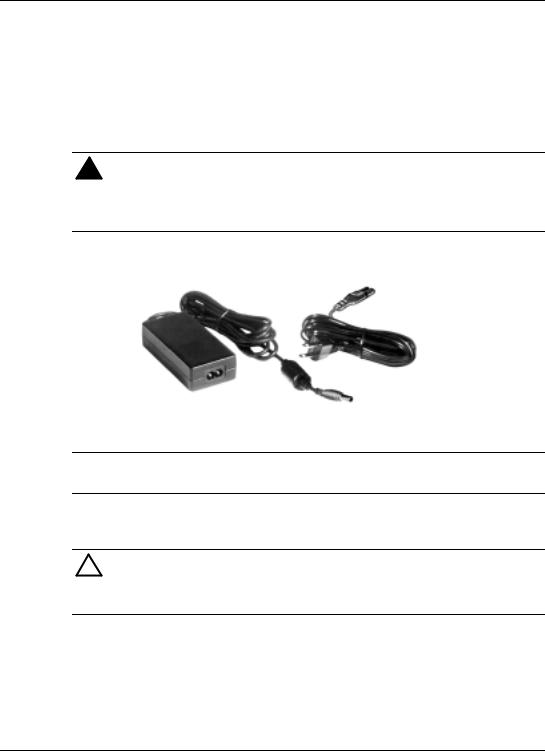
Using the AC Adapter
Use the AC adapter and power cable that came with your NEC Versa VX to run your computer on alternating current (AC) power, or to recharge the battery pack. Use the AC adapter whenever a wall outlet is nearby.
When connected, the AC adapter charges the battery whether or not the NEC Versa VX is powered on.




 Do not attempt to disassemble the AC adapter. The AC adapter has no user-replaceable or serviceable parts inside. Dangerous voltage in the AC adapter can cause serious personal injury or death. The AC adapter is intended for use with a computer. Both must meet EN60950 standards.
Do not attempt to disassemble the AC adapter. The AC adapter has no user-replaceable or serviceable parts inside. Dangerous voltage in the AC adapter can cause serious personal injury or death. The AC adapter is intended for use with a computer. Both must meet EN60950 standards.
AC adapter
Note The AC outlet voltage should be in the range of 100–240 Volts AC. Verify that the cord and plug are appropriate for your AC source.
Connect the AC adapter as follows:




 Use only the AC adapter that comes with your NEC Versa VX system. Although other AC adapters may look similar, using them can damage the system.
Use only the AC adapter that comes with your NEC Versa VX system. Although other AC adapters may look similar, using them can damage the system.
1.Connect the AC adapter cable to the power port on the back of your NEC Versa VX system.
2-4 Getting Started
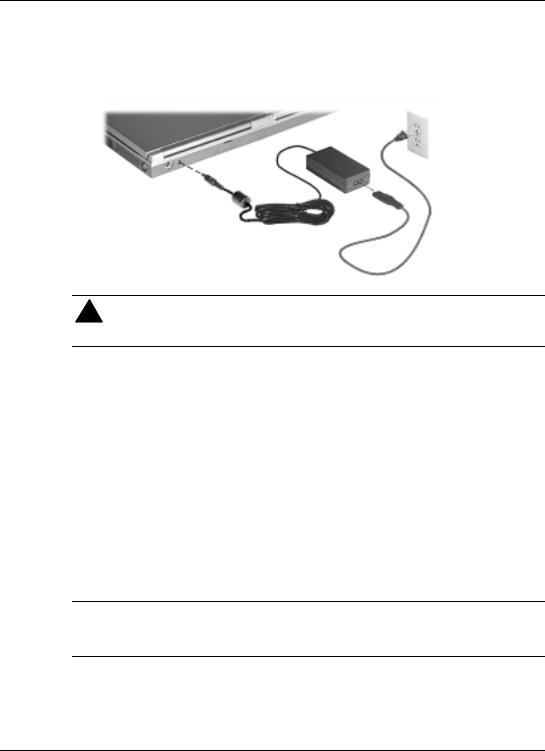
2.Plug one end of the AC power cable into the AC adapter and the other end into a 120or 240-volt wall outlet.
Connecting the AC adapter




 Do not cover or place objects on the AC adapter. Doing so can cause the adapter to overheat.
Do not cover or place objects on the AC adapter. Doing so can cause the adapter to overheat.
Powering the System On and Off
To power on, locate the Power button on the upper right hand side of the notebook above the keyboard and press it. To power off the system, press the Power button. In Windows, the computer automatically shuts down, when “Shut Down” is selected from the Start menu. That is, you do not need to press the Power button to switch off the computer.
Depending on the operating system, the “smart” switch may be enabled to allow you to power down using the Power button instead of the Windows Start menu.
Using the Battery
The NEC Versa VX system comes with a rechargeable Nickel Metal-Hydride (NiMH) or Lithium-Ion (Li-Ion) battery. Battery packs are easy to install and remove.
Note Although the battery is fully charged at the factory, transit and shelf time may reduce the initial battery charge. We recommend that the first time you use your system, connect it to AC power using the AC adapter. This also recharges your battery.
When battery power drops to the level where the Battery Warning is activated, the power LED lights yellow.
Getting Started 2-5
